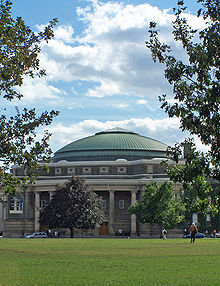Convocation Hall (University of Toronto)


Convocation Hall is a domed rotunda on the grounds of the University of Toronto in Toronto, Ontario, Canada. Designed by Pearson and Darling and completed in 1907, it was inspired by the grand theatre of the Sorbonne and the Sheldonian Theatre at Oxford.[1] The building primarily serves as the venue for the annual convocation ceremonies, in addition to hosting academic and social functions throughout the year.[2]
Seating 1,731 people, Convocation Hall serves as U of T’s largest classroom, where many lectures take place. It has four stories, two main seating floors as well as an attic and a basement.
Attached in the rear of Convocation Hall are the Examination Hall (used previously as an exhibition hall and today as an exam room) and Simcoe Hall (which houses the university’s executive offices), also built by Darling and Pearson Architects.
The building appears in the film Mean Girls and in the pilot episode of the television series Fringe.
History
Built by funds contributed by graduates and friends of the university and a grant from the Ontario government, the alumni association managed to raise more than $50,000 for the construction of Convocation Hall, which the government then matched. U of T’s first Convocation Hall was destroyed in a fire in 1890 at another location. The need became apparent for a considerably larger ceremonial auditorium beyond the confines of University College.[3] The cornerstone was laid in 1904 and the construction completed three years later at almost twice the originally estimated cost. The building became equipped with air conditioning in 1997[4] and in 2007 celebrated its centennial.
Songs on Premiata Forneria Marconi's album Live in USA were recorded at the hall in 1974. Bob Marley & The Wailers performed two shows of the Rastaman Vibration Tour there in 1976. Zimbabwean President Robert Mugabe gave an address to a capacity crowd there in the 1980s.
The building hosted a recording of musician Hayden's live album, titled simply Live at Convocation Hall, in 2002. In 2007, former Vice President of the United States Al Gore delivered a public lecture on climate change at Convocation Hall and presented his documentary film, An Inconvenient Truth. In 2009, Michael Ignatieff was at the hall to launch his book, True Patriot Love.
Over the years, there have been major renovations and alterations done to the building. These include:
- 1912 – Large pipe organ installed in the hall
- 1947 – Alteration and addition to Examination Hall
- 1997 – Air conditioning put in the building
- 2006 – Restoration and refurbishment campaign by University of Toronto Alumni Association (UTAA) by E.R.A Architects Inc. Work entailed refurbishing seats, restoration of grandeur of the circular foyer including decorative finishes, historical millwork, lighting installations and a fresh coat of paint, and restoration of the historic pipe organ—the fifth largest in Toronto.
Architecture


Convocation Hall is a structure with great historical and architectural significance. It was built during a time of great technological, industrial and cultural change.[5] It was also a time of great architectural change. Architect Frank Darling was influenced by the neoclassical revival in architecture from the mid-18th century and the Greek revival of the 19th century. The design of Convocation Hall was to be that of a classical revival building, with historic neoclassical features and elements incorporated into the modern structure of the hall. In the case of Convocation Hall these elements are from both the Greek and Roman periods and include columns, the building's entablature, and its domed roof. There is an emphasis on principles of proportion, symmetry, geometry and uniformity of parts. The Hall's design reflects a formal character which reflects strength and inspires pride. It incorporates a repeating pattern of circular forms to convey messages of centrality and inclusiveness. The purpose of these circular forms was to make Convocation Hall both the metaphorical and physical centre of the expanding University.[6]
The two most dominant and accentuated features of Convocation Hall are its exterior columns and the large domed roof. The columns are a cross between Doric and Ionic columns, as they consist of features typically seen on each type. There is a Doric style fluted shaft to the column, which is very chubby in form with a very large base. While at the top of the column lies a typically Ionic capital. The large domed roof is made of copper, which has oxidized into the classic green frequently seen in historic Canadian buildings. At the centre of this domed roof is a large glass oculus, which allows in great amounts of natural lighting into the centre of the large hall beneath. Supporting this domed roof are strong structural beams which interiorly form into arches between the balcony seating on the third floor of the Hall. Materials used in the construction include glazed yellow and grey stock brick, prefabricated cement panels, concrete, glass, copper, plaster, terrazzo and wood.
References
- ^ Raymer, Elizabeth (2006). "Alumni Launch Campaign to Restore Convocation Hall". University of Toronto Magazine (Spring 2006). Retrieved 2009-07-18.
- ^ Duffy, Dennis (2002). "As Canadian as a Snowflake". University of Toronto Magazine (Spring 2002). Retrieved 2009-07-18.
- ^ University of Toronto - News@UofT - Your Thoughts - Celebrating Convocation Hall's centennial (Jun 14/07)
- ^ U. of T. The Bulletin, June 9, 1997, Articles
- ^ Eksteins, Modris (12). "Celebrating Convocation Hall's centennial". University of Toronto Bulletin: 16–20.
{{cite journal}}: Check date values in:|date=and|year=/|date=mismatch (help); Unknown parameter|month=ignored (help); line feed character in|journal=at position 22 (help) - ^ Scott, Graham F. "A Century at Convocation Hall." UofT Magazine Autumn 2007: n. pag. Web. 15 Feb 2011. http://www.magazine.utoronto.ca/autumn-2007/convocation-hall-ceremony-u-of-t-traditions/.

